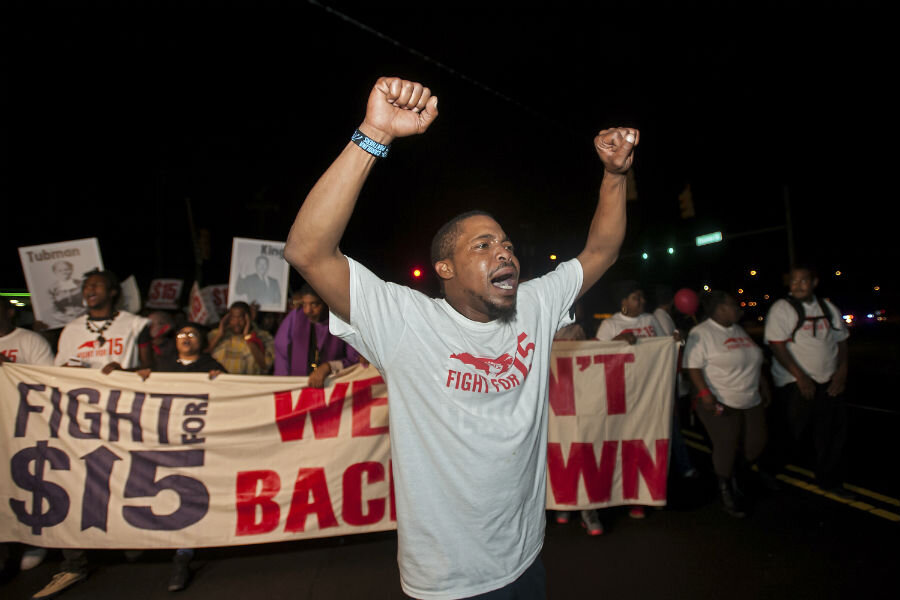How the Fight for $15 movement could survive the Trump era
Loading...
Thousands of service-industry workers rallied in dozens of cities across the United States on Tuesday, shutting down roads and walking off the job in airports to agitate for a $15 minimum wage.
Fast-food workers joined janitors, Uber drivers, and home- and child-care providers in calling for a $15 minimum wage outside of McDonald’s restaurants, reported Reuters, while airport employees in Chicago; Washington, D.C.; Boston; and Atlanta demonstrated outside of terminals. Well over 100 demonstrators were arrested, including four local officials in New York City.
The actions were the largest coordinated effort from the Fight for $15 campaign since its inception in 2012. The protests come on the heels of a transformative election for the political symbolism of labor, with Donald Trump claiming the mantle of the white, male manufacturing worker – historically a Democratic-allied group.
President-elect Donald Trump has said that he might support a $10-plus minimum wage, while leaving subsequent increases for the states to decide, though in 2015 he said that workers’ wages were already “too high.”
Whatever happens at the federal level, the minimum wage movement and the slogan "Fight for $15" have proven successful at changing minimum wage laws at the state and local level, says Ben Zipperer, an economist at the Economic Policy Institute who studies minimum wage increases.
"It’s been pushing companies to increase their low-skilled and entry-level wages and also changed the conversation about national policy," he tells The Christian Science Monitor.
Since 2012, 29 states and 51 cities have passed minimum wage increases, with some, like California and Washington, D.C., on track to reach the symbolic $15-an-hour level, more than twice the federal minimum.
To explain these successes, experts point to the decision to make the minimum-wage fight a general political cause, using protests and other publicity-raising measures to achieve increases, rather than organizing unions and bargaining with individual companies, as The New York Times noted on Tuesday.
Election Day netted the movement its latest advances. In ballot measures, Maine, Arizona, and Colorado voted to boost their states’ minimum wages to $12 an hour, with subsequent cost-of-living increases, while Washington state voters raised the hourly rate to $13.50, as the Monitor’s Amanda Hoover reported.
Those new laws are buttressed by a growing number of studies that compare data from similar, neighboring counties with different wage laws, and turn up little negative effect on employment. Those studies, says Dr. Zipperer, “provide intellectual heft to the movement.”
Despite concerns that the Trump administration could dismantle collective bargaining rights, observers note that the Fight for $15 movement has never relied too greatly on Congress or the White House.
That’s not to say that labor organizers don’t see storm clouds ahead: the Times reports that the idea of staging strikes at airports, instead of just demonstrating there, originated after the election.
"Today, there is a renewed sense of urgency because of the results of the election," said Luisa Blue, executive vice president of the Service Employees International Union, at a demonstration held at Reagan National Airport, noted US News and World Report.
"But the underlying struggles of these workers and their need for $15 and worker organizations, the need to fight against racism, the need to fight against deportations, hasn't changed," she said. "And we are not going to back down."








